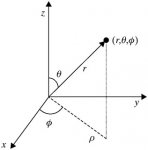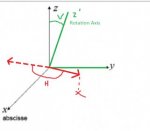Hello everyone,
I'm encountering a difficult math problem at work, and I'd appreciate any help you could give me.
I'm currently working on data sets of light intensity vs. direction measurements, and I have to navigate between two coordinate systems.
The first one is the classical spherical coordinate system, polar axis, theta and phi angle, as illustrated here :

Since I'm interested only in directions, the coordinate r is of no interest.
The second one is a bit more esoteric, it's a system associated with goniometric measurement. It involves two angular coordinates which we call H and V (for horizontal and vertical), and its definition is closely linked to our measurement protocol.
To derive the direction from the coordinates, you have to do the following steps :
- First, the x-axis is rotated of an angle V, around the y-axis.

- Then, the previously rotated axis, is rotated of an angle H around the z' axis, which is the z axis submitted to the same rotation as the x-axis in the first step :

My question is the following, if I know the H and V angular coordinates in the second coordinate system, how can I derive the spherical coordinates (with polar axis x) of this direction ?
I know it's not a simple question, and my English might not be that good, but I'm at a loss as how to proceed here. If anyone here have encountered a similar problem, have a clue on how to proceed (or just irrationally enjoys spherical geometry ), I would be really grateful.
), I would be really grateful.
Thanks !
I'm encountering a difficult math problem at work, and I'd appreciate any help you could give me.
I'm currently working on data sets of light intensity vs. direction measurements, and I have to navigate between two coordinate systems.
The first one is the classical spherical coordinate system, polar axis, theta and phi angle, as illustrated here :

Since I'm interested only in directions, the coordinate r is of no interest.
The second one is a bit more esoteric, it's a system associated with goniometric measurement. It involves two angular coordinates which we call H and V (for horizontal and vertical), and its definition is closely linked to our measurement protocol.
To derive the direction from the coordinates, you have to do the following steps :
- First, the x-axis is rotated of an angle V, around the y-axis.

- Then, the previously rotated axis, is rotated of an angle H around the z' axis, which is the z axis submitted to the same rotation as the x-axis in the first step :

My question is the following, if I know the H and V angular coordinates in the second coordinate system, how can I derive the spherical coordinates (with polar axis x) of this direction ?
I know it's not a simple question, and my English might not be that good, but I'm at a loss as how to proceed here. If anyone here have encountered a similar problem, have a clue on how to proceed (or just irrationally enjoys spherical geometry
Thanks !
